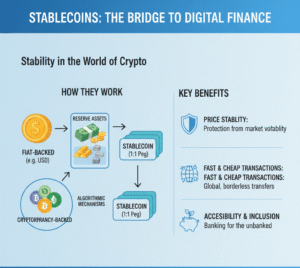Introduction to stablecoins and credit card fees
Stablecoins are digital tokens pegged 1:1 to a stable fiat currency like the U.S. dollar, and they offer a new way for businesses to accept payments. However, conventional credit card transactions remain expensive. In the U.S., payment card processors usually charge businesses between 1 % and 3 % per transaction, and American merchants collectively spend about $160 billion every year on processing fees.
Therefore, a small café or online retailer may lose a significant portion of each sale to card networks and banks. Moreover, credit card settlements can take several days, and merchants must wait to see their funds. Consequently, small businesses are searching for alternatives that reduce fees while maintaining customer convenience.
________________________________________________________________________________
Why credit card fees are a burden for small businesses
High transaction fees are particularly painful for low‑margin businesses. For example, a coffee shop selling a $4 latte might pay a flat fee plus 2 %–4 %, meaning only $3.60 reaches the owner. In addition, merchants also face the risk of chargebacks and hidden costs, and wire transfers can cost $25–$50 per transaction.
Across the United States, small retailers lose almost 4 % of their revenue on every credit card swipe. Since cash usage declines and more customers prefer cards, these costs accumulate quickly. Therefore, credit card fees cut into profits that could otherwise be reinvested into staff, equipment or marketing.
________________________________________________________________________________
How stablecoins work and their benefits

Stablecoins are designed to avoid volatility by being backed by cash or short‑term U.S. Treasury bonds; the GENIUS Act signed in 2025 mandates strict 1:1 backing for regulated stablecoins. As a result, payments denominated in stablecoins operate like digital cash: customers send tokens, and merchants receive funds in seconds with near‑zero cost. Furthermore, stablecoins have transaction fees typically under 1 %, compared to credit cards’ 2 %–4 %.
Because settlements are instant and final, there are no chargeback risks and funds are available immediately. Additionally, stablecoins can settle cross‑border transactions without currency conversion fees, making them attractive to businesses paying overseas suppliers. Regulation, such as the EU’s MiCA framework and the U.S. law mentioned above, provides oversight and consumer protection, encouraging adoption.
________________________________________________________________________________
Real‑world examples of small businesses using stablecoins
Compass Coffee
Compass Coffee, a veteran‑owned chain in Washington D.C., loses almost 4 % of its revenue to credit card fees, so it piloted payments in USD Coin (USDC). During the one‑day experiment, customers could pay for their drinks using stablecoins through Coinbase, and the owners highlighted how money moved with the speed of the internet without intermediaries. Thus, stablecoins offered a way to protest “junk fees” while exploring an efficient payment option.
________________________________________________________________________________
Mercado Libre and supplier payments
Latin American marketplace Mercado Libre uses USDC through a partner to pay sellers in Brazil and Mexico. Because bank transfers and cross‑border wires are slow and expensive, using stablecoins cuts transaction costs and pays suppliers faster. This demonstrates how stablecoins can solve liquidity challenges for businesses operating across borders. Moreover, remote contractors working for global clients are now being paid in USDC, receiving funds instantly in 69 countriesforvismazars.us.
________________________________________________________________________________
Small retailers and e‑commerce platforms
Small retailers around the world are adopting stablecoins through crypto‑friendly point‑of‑sale systems. For instance, a burger chain like Steak ’n Shake has enabled customers to pay with stablecoins, while freelancers and subscription software platforms accept USDC for instant global payoutstryspeed.com. Consequently, these businesses avoid the 2 %–4 % fees and delays associated with card processors and offer customers modern payment options.
Also, Canadian payment processor Peloton notes that when a business invoices on Friday, a stablecoin payment can arrive by Saturday morning, unlike credit card settlements that take days. Additionally, removing intermediaries can save a percentage point on each transaction, adding up to thousands of dollars per yearpeloton-technologies.com.
________________________________________________________________________________
Preparing for adoption and future outlook
Although stablecoins still represent an emerging technology, their use is growing rapidly. In fact, stablecoins processed $27.6 trillion in payments in 2024, more than Visa and Mastercard combinedetaslf.com. Major card networks and fintech firms are exploring ways to integrate stablecoins, and Visa recently announced a pilot that uses stablecoins for prefunding cross‑border payments, freeing liquidity and settling transactions within minutes.
Because the GENIUS Act and similar regulations provide clarity, businesses will soon be able to adopt stablecoins with confidence. Therefore, small business owners should talk to payment processors and accountants now to understand how to accept stablecoins, integrate digital wallets and manage conversions back to fiat. Moreover, early adopters can attract tech‑savvy customers and gain a competitive edge as the digital economy evolves.
________________________________________________________________________________
Stablecoins offer a promising alternative to credit cards, enabling small businesses to slash transaction fees, speed up settlements and expand globally. While regulation and education are still needed, real‑world examples from Compass Coffee, Mercado Libre and freelancers show that digital dollars can solve pain points for merchants. Therefore, by embracing stablecoins, small business owners worldwide can keep more of their hard‑earned revenue and serve customers in a faster, fairer and more innovative way.
________________________________________________________________________________









